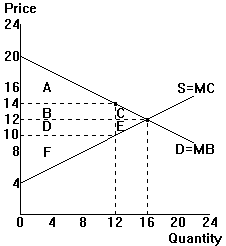With perfect competition: Q=16, P=12
With market power: Q=12, P=14

Market power: Capturing consumer surplus
"People of the same trade seldom meet together, even for merriment or diversion, but the conversation ends in a conspiracy against the public, or some contrivance to raise price." Adam Smith, 1776
| The diagram to the right illustrates an initially competitive
industry whose producers then agree on a "contrivance to raise price."
With perfect competition: Q=16, P=12 |
 |
| Areas in the diagram | Dollar values | |||||
| Competition | Monopoly | Change | Competition | Monopoly | Change | |
| Consumer surplus | ABC | $64 | ||||
| Producer surplus | DEF | $64 | ||||
| Social welfare | ABCDEF | $128 | ||||
*Note that the change in social welfare is the welfare loss ("deadweight loss") resulting from the exercise of market power.
"Consumption is the sole end and purpose of all production, and the interest of the producer ought to be attended to only so far as it may be necessary for promoting that of the consumer. the maxim is so perfectly self-evident that it would be absurd to attempt to prove it." Adam Smith
Question: If the government imposed a $12 price ceiling in this industry, how much would the producers sell to maximize their producer surplus? _________ How large would the welfare loss be then? _________